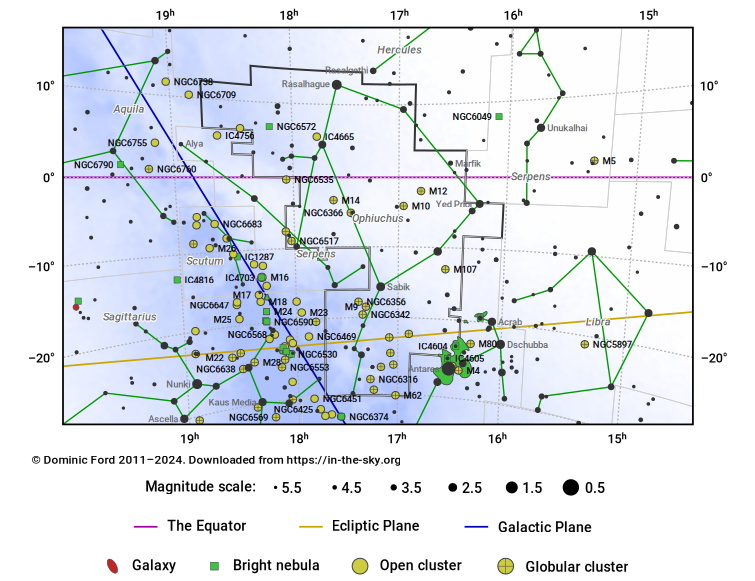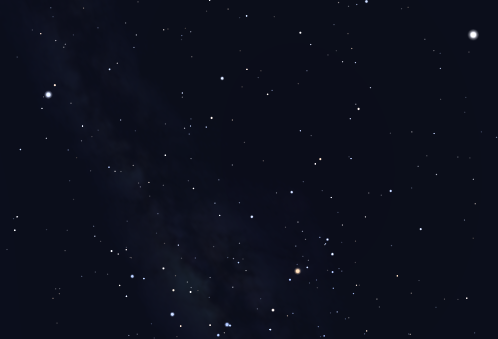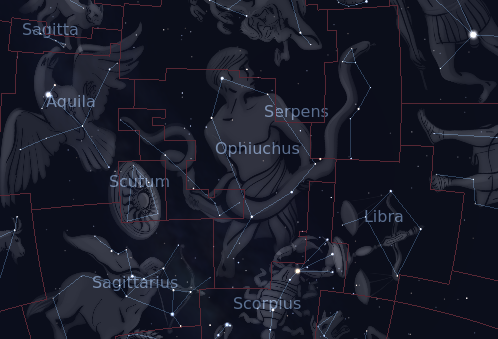The Constellation Ophiuchus
Ophiuchus is a large equatorial constellation which appears highest in the midnight sky in the months around June.
It lies just north of the Milky Way and encompasses a particularly rich part of the galaxy. Our sight line towards the center of the galaxy lies not far away, in the neighboring constellation of Sagittarius.
This means that Ophiuchus is exceptionally rich in globular clusters, which mostly lie in spherical swarm around the galaxy's center. Ophiuchus alone contains no fewer than 16 that are brighter than tenth magnitude, second only to Sagittarius which contains 18 clusters of the same brightness.
Although Ophiuchus is not among the twelve traditional constellations of the zodiac, the Sun passes through its southern extremities for around two weeks each year in early December. Ophiuchus is the only constellation other than the traditional twelve that the Sun passes through, making it effectively a thirteenth zodiacal constellation.
On sky charts, Ophiuchus is depicted as a man holding a serpent, often identified as Asclepius, the god of medicine. The figure's brightest star is named Rasalhague, Arabic for ‘the head of the serpent collector’.
Ancient
2.3% of the sky
948.3 square degrees
Ophiuchus contains no Caldwell objects
The following constellations neighbor Ophiuchus: Aquila, Hercules, Libra, Sagittarius, Scorpius, Serpens Caput, Serpens Cauda.
Hover the pointer over the name of an object to highlight its position on the starchart to the right, or click to see more information.
| Stars | Open Clusters | Globular Clusters | Galaxies |
| Rasalhague (mag 2.1) | IC 4665 (mag 4.2) | Messier 12 (mag 6.1) | NGC 6384 (mag 10.6) |
| Sabik (mag 2.4) | NGC 6633 (mag 4.6) | Messier 62 (mag 6.4) | NGC 6570 (mag 12.7) |
| ζ-Oph (mag 2.6) | NGC 6481 | Messier 10 (mag 6.6) | NGC 6240 (mag 13.3) |
| Yed Prior (mag 2.7) | NGC 6525 | Messier 19 (mag 6.8) | NGC 6509 (mag 13.3) |
| Cebalrai (mag 2.8) | Messier 14 (mag 7.6) | NGC 6368 (mag 13.6) | |
| κ-Oph (mag 3.2) | Messier 107 (mag 7.8) | IC 1255 (mag 14.2) | |
| Yed Posterior (mag 3.2) | Messier 9 (mag 7.8) | NGC 6296 (mag 14.2) | |
| θ-Oph (mag 3.3) | NGC 6356 (mag 8.2) | NGC 6615 (mag 14.5) | |
| ν-Oph (mag 3.3) | NGC 6304 (mag 8.3) | IC 4688 (mag 14.6) | |
| 72-Oph (mag 3.7) | NGC 6293 (mag 8.3) | IC 1242 (mag 14.9) | |
| γ-Oph (mag 3.7) | NGC 6355 (mag 8.6) | NGC 6378 (mag 15.0) | |
| 67-Oph (mag 4.0) | NGC 6284 (mag 8.9) | NGC 6220 (mag 15.2) | |
| p-Oph (mag 4.1) | NGC 6235 (mag 8.9) | NGC 6234 (mag 15.3) | |
| Marfik (mag 4.1) | NGC 6316 (mag 9.0) | IC 4691 (mag 15.4) | |
| b-Oph (mag 4.2) | NGC 6287 (mag 9.3) | IC 4676 (mag 15.6) | |
| χ-Oph (mag 4.3) | NGC 6366 (mag 9.5) | IC 4627 (mag 16.1) | |
| d-Oph (mag 4.3) | NGC 6342 (mag 10.0) | ||
| φ-Oph (mag 4.3) | NGC 6517 (mag 10.3) | ||
| σ-Oph (mag 4.3) | NGC 6325 (mag 10.7) | ||
| ι-Oph (mag 4.4) | NGC 6401 (mag 10.7) | ||
| ξ-Oph (mag 4.4) | NGC 6426 (mag 10.9) | ||
| 68-Oph (mag 4.4) | IC 1257 | ||
| ω-Oph (mag 4.4) | |||
| ψ-Oph (mag 4.5) | |||
| 47-Oph (mag 4.5) | |||
| μ-Oph (mag 4.6) | |||
| υ-Oph (mag 4.6) | |||
| 20-Oph (mag 4.6) | |||
| 71-Oph (mag 4.6) | |||
| V2048 Oph (mag 4.8) |




